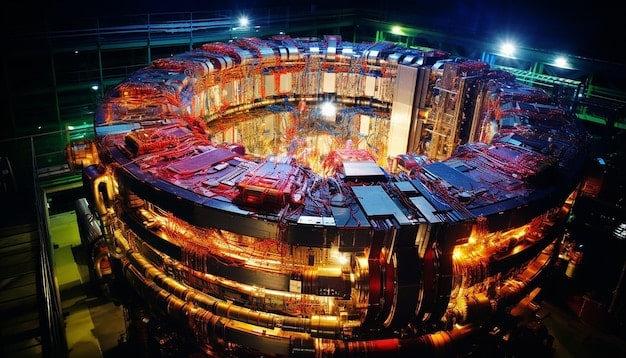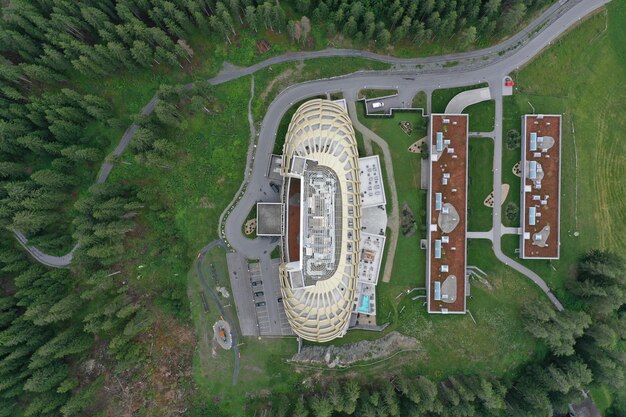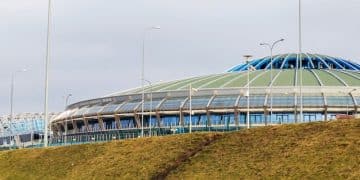MLS Stadium Development: Boosting Fan Engagement with New Venues

MLS stadium development focuses on enhancing fan engagement through modern venues, incorporating cutting-edge technology, diverse amenities, and community-centric designs to create an immersive and memorable experience.
The landscape of Major League Soccer (MLS) is constantly evolving, and a key aspect of this evolution is MLS stadium development: How new venues are boosting fan engagement. These aren’t just arenas for watching soccer; they’re carefully designed spaces meant to create memorable experiences.
The rise of soccer-specific stadiums
Soccer-specific stadiums (SSS) have revolutionized the MLS experience. These venues are designed with soccer in mind, offering better sightlines and acoustics.
Here’s a look at how they enhance the game:
Intimate atmosphere
SSS’s create a more enclosed, intense experience. This enhances the feeling of being close to the action and amplifies crowd noise, creating a more intimidating environment for opponents.
Better sightlines
Designed specifically for soccer, these stadiums ensure optimal viewing angles from every seat. Fans get a clearer, more engaging view of the entire field.
The advantages of soccer-specific stadiums are numerous:
- Improved fan experience: Intimate settings and better sightlines lead to a more immersive and enjoyable game day.
- Increased revenue: Modern amenities and premium seating options drive higher ticket sales and revenue.
- Community integration: Stadiums often become hubs for community events, fostering a stronger connection between the team and its supporters.
In summary, soccer-specific stadiums mark a shift toward prioritizing fan engagement and creating a unique soccer culture within the MLS.

Design and amenities driving fan experience
Modern MLS stadiums aren’t just about the game; they’re about the entire fan experience. State-of-the-art design and amenities play a crucial role.
Let’s see how that impacts the fan:
Technological integration
Wi-Fi, interactive displays, and mobile ticketing enhance convenience. Augmented reality (AR) and virtual reality (VR) experiences are also becoming more common, offering fans interactive content.
Premium seating options
Luxury suites, club lounges, and field-level seating cater to a higher-end clientele. These premium options offer exclusive amenities like private bars, gourmet food, and VIP access.
Design and amenities work together to create a complete experience:
- Technology: Keeps fans connected and informed throughout the event.
- Comfort: Ensures fans enjoy the game in a relaxed and welcoming atmosphere.
- Luxury: Offers high-end options for those seeking an exclusive experience.
Ultimately, modern stadium design focuses on integrating technology, comfort, and luxury to enhance fan engagement and satisfaction.
The economic impact of new stadiums
New MLS stadiums have a significant economic impact on their surrounding communities. They create jobs, attract tourism, and stimulate local businesses.
Here’s a breakdown of the economic boosts:
Job creation
Construction of a new stadium creates construction jobs. Ongoing operations require staff for ticketing, concessions, security, and maintenance.
Increased tourism
New stadiums attract fans from out of town, boosting local hotels, restaurants, and shops. Special events like concerts and festivals further drive tourism revenue.
Consider these economic benefits:
- Local business growth: Stadiums stimulate demand for local goods and services, providing opportunities for small businesses.
- Property value appreciation: Development around the stadium often leads to increased property values.
- Tax revenue: Increased economic activity generates higher tax revenue for the local government.
In sum, new MLS stadiums serve as economic catalysts, creating jobs, attracting tourism and stimulating local businesses.
Community engagement and stadium integration
Successful MLS stadiums integrate with their communities, offering more than just soccer games. They often include community spaces and programming.
Let’s check how that works:
Community spaces
Stadiums can include parks, plazas, and community centers. These spaces give residents a place to gather, exercise, and socialize, increasing community cohesion.
Youth programs
Many teams offer youth soccer programs, clinics, and camps at their stadiums. These activities promote health, fitness, and a love of soccer among young people.

Some things stadiums offer to foster a great connection with the community:
- Partnerships: Collaborations with schools, nonprofits, and local organizations help extend the stadium’s reach into the community.
- Events: Hosting community events such as summer movie nights and farmers markets, making the stadium a central gathering place.
All in all, MLS stadiums that integrate with their communities create a sense of pride, belonging, and shared identity, strengthening bonds between the team and its supporters.
Sustainability initiatives in stadium development
Sustainability is increasingly important in MLS stadium development. Teams are focusing on reducing their environmental impact.
Here are a few key areas:
Energy efficiency
Stadiums are designed to minimize energy consumption through efficient lighting, HVAC systems, and building materials. Renewable energy sources such as solar panels are also growing in popularity.
Waste reduction
Recycling programs, composting initiatives, and reusable serving ware are implemented to minimize waste. Water conservation measures such as rainwater harvesting and low-flow fixtures also help conserve resources.
Sustainable choices in stadium development are vital:
- Green building certifications: LEED certification ensures stadiums meet high standards of environmental performance.
- Community impact: Sustainable practices enhance the quality of life for local residents, making stadiums a positive addition to the community.
In conclusion, sustainability is integrated into new MLS stadium projects, emphasizing energy efficiency and waste reduction.
Case studies: success stories in MLS stadium development
Several MLS teams have successfully leveraged new stadiums to boost fan engagement. These case studies provide valuable insights.
Let’s view some examples:
Allianz Field (Minnesota United FC)
Allianz Field is renowned for its unique design, steep seating, and vibrant atmosphere. The stadium includes a brew hall and a standing-only supporters section, fostering community and excitement.
Audi Field (D.C. United)
Located in the heart of Buzzard Point, Audi Field revitalized a neglected neighborhood. The stadium features a waterfront view, premium seating, and community gathering spaces, enhancing fan engagement and neighborhood development.
These successes demonstrate the value of:
- Fan-centric design: Allianz Field’s steep seating and brew hall create an immersive and sociable atmosphere.
- Community integration: Audi Field is integrated with the surrounding neighborhood, offering community spaces and programming.
In short, real-world examples underscore the value of fan-centric design and deep community integration when it comes to stadium development and fan engagement.
Future trends in MLS stadium development
The future of MLS stadium development is focused on innovation, technology, and enhanced fan experiences. These trends aim to drive fan engagement even further.
Here are some points for the future:
Smart stadium technology
Advanced sensors, data analytics, and personalized mobile apps will customize fan experiences. Predictive analytics will optimize stadium operations, improving crowd management, security, and concessions.
Multi-use facilities
Stadiums will become mixed-use destinations, incorporating restaurants, retail shops, hotels, and residential units. This allows stadiums to generate revenue beyond game days and provide year-round value for the community.
To stay relevant in the future, stadiums must:
- Adapt to changing technology: Embracing new technologies is critical to providing cutting-edge fan experiences.
- Cater to fan preferences: Understanding and responding to fan needs is essential for attracting and retaining a loyal fan base.
In the final analysis, the future of MLS stadium development will center around creating smart, multi-use, fan-focused facilities, aimed at providing enhanced experiences and driving long-term fan engagement.
| Key Point | Brief Description |
|---|---|
| ⚽ Soccer-Specific Stadiums | Enhance fan experience with better sightlines and intimate atmosphere. |
| 🏟️ Stadium Design & Amenities | Integrate technology and premium seating for a complete fan experience. |
| 💸 Economic Impact | Boost local economies through job creation and increased tourism. |
| 🌱 Sustainability | Focus on energy efficiency and waste reduction for environmental responsibility. |
FAQ
▼
New MLS stadiums enhance the fan experience through better sightlines, modern amenities, and technological integrations, creating a more immersive and enjoyable environment.
▼
Soccer-specific stadiums are designed with soccer in mind, featuring intimate atmospheres, steeper seating, and better acoustics optimized for the sport.
▼
MLS stadiums drive local economies by creating jobs, attracting tourists, and stimulating business growth in surrounding areas through increased traffic and spending.
▼
New stadiums include sustainable features like energy-efficient lighting, recycling programs, renewable energy sources, and water conservation technologies to minimize environmental impact.
▼
Future MLS stadiums will likely integrate smart technology, multi-use facilities, and personalized fan experiences to provide year-round value and engagement for the community.
Conclusion
In conclusion, MLS Stadium Development: How New Venues Are Boosting Fan Engagement represents a transformative shift in the league’s approach to fan experience. By focusing on soccer-specific design, technological integration, and community engagement, these new venues not only elevate the game day atmosphere but also contribute to the economic and social fabric of their surrounding areas, setting a new standard for sports and entertainment experiences.





